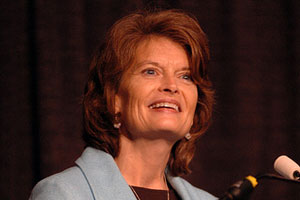
Flickr/<a href="http://www.flickr.com/photos/senatorlisamurkowski/4421978595/in/set-72157623592449150/">U.S. Senator Lisa Murkowski</a> (<a href="http://creativecommons.org/">Creative Commons</a>)
Incumbent Republican Sen. Lisa Murkowski is not on the ballot in Alaska this November, but she’s still favored to win, with the most recent polls showing her in a dead heat with Joe Miller, the tea party candidate that unexpectedly defeated her in the primary. She’s also crushing Miller and her Democratic opponent Scott McAdams in fundraising—but as her campaign disclosures show, it’s not Alaskans that are dumping money into her write-in campaign. The vast majority of her funds have come from out-of-state oil, gas, and coal interests.
Murkowki’s raked in more than $2.3 million this year, to Miller’s $1.4 million and McAdam’s $687,000. As I noted last week, Murkowski has benefited from the support of a new Super PAC, Alaskans Standing Together, which has received contributions exclusively from corporations. But at least they are Native Alaskan corporations. Eighty-nine percent of her money is coming from out of state, according to data compiled by the Sunlight Foundation, and energy companies are by far her biggest industry supporters.
Galliano, Louisiana-based Edison Chouest Offshore, which provides vessels for offshore drillers, is her biggest donor at $36,250. Maryland-based Constellation Energy comes in second, at $34,646. ExxonMobil, which is based in Houston, has ponied up $20,500. In fourth place at $17,400 is Van Ness Feldman, a DC-based lobbying shop that works for a number of electric utilities, natural gas and oil services companies, and mining interests. The Texas-based pipeline company Energy Transfer Equity and Missouri-based coal company Peabody Energy come fifth and sixth among her top donors, respectively.
As ranking minority member of the Energy and Natural Resources Committee, Murkowski holds quite a bit of sway in her post. In the past few years she has worked closely with chairman Jeff Bingaman (D-NM) on a number of bills. She was also at the helm of multiple attempts to shut down the Environmental Protection Agency’s regulation of greenhouse gases and has been the leader in pushing to open the Arctic National Wildlife Refuge for oil and gas drilling. Even though some of her GOP colleagues have not hidden their unhappiness about her write-in bid to upset Miller, so far they’ve allowed her to keep her seat on the committee. If Republicans manage to take the majority in the Senate, she’d be in line to serve as the panel’s chair.
In turn, Murkowski’s been busy touting how much her leadership position means for the state. (Her website is topped with a big drop-down banner asking, “What has Lisa’s seniority in the Senate delivered for Alaska?” and links to a page that lists things like securing funding for the first mobile geothermal turbine and the Alaska Native Tribal Health Consortium among her accomplishments.) Yet Murkowski’s campaign records show exactly whose priority it is to keep her in the Senate—and it’s not Alaskans.









